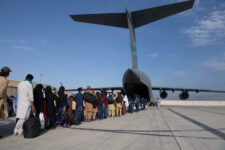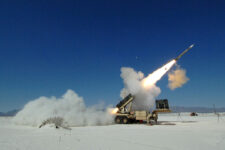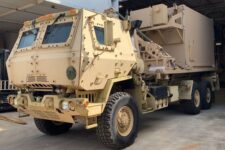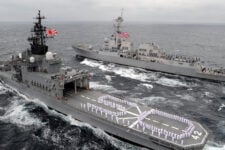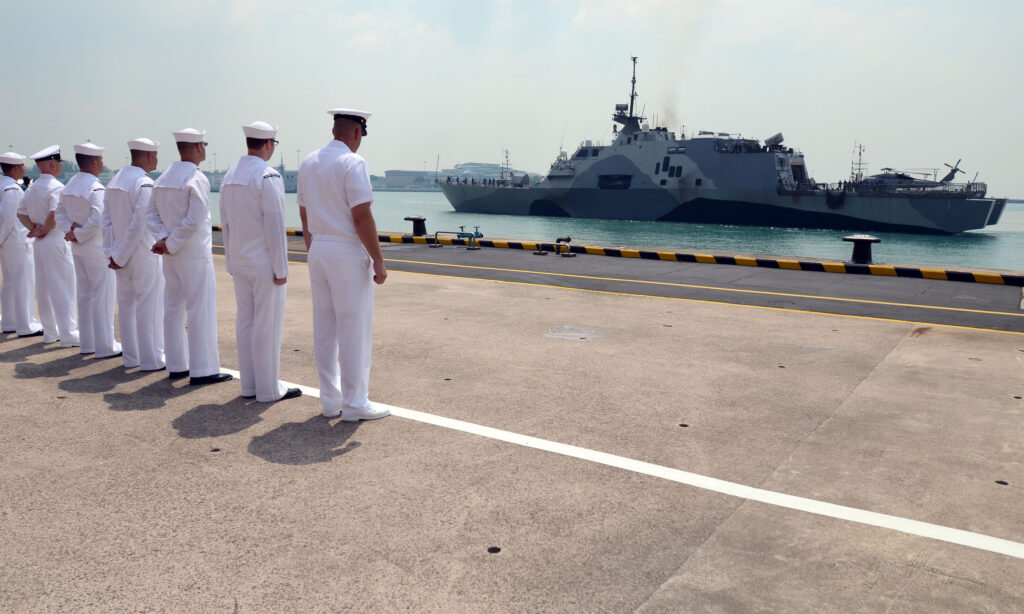
The Littoral Combat Ship FREEDOM pulls into Singapore, an increasingly important partner in the Pacific.
WASHINGTON: Some 45 football fields and gear worth $5 billion. That’s how much excess inventory and storage room the Defense Logistics Agency has sold or destroyed since the height of the wars in Afghanistan and Iraq, and it’s not finished. DLA’s first sale of surplus equipment to local businesses in Afghanistan is scheduled for next week, its director told reporters this morning. But DLA’s job isn’t just downsizing for the post-war, post-sequestration era, Vice Adm. Mark Harnitchek made clear: It’s also rebuilding a worldwide supply system to support the new national strategy, from Africa to the West Pacific.
“The big one for us in terms of the pivot to the Pacific is fuel,” Harnitchek said. While Napoleon’s army marched on its stomach and Nelson’s fleet depended on the wind, the modern US military guzzles gas, especially for aircraft. The Air Force’s recent decision to move from military-specification jet fuel to commercial fuel has made a major difference, Harnitchek said: Not only will it save millions of dollars, it will also allow the use of vastly more suppliers and storage sites worldwide. Nevertheless, the operational plans for Pacific still require DLA to provide “millions of barrels” of fuel across thousands of miles of distance.
Already, he said, “we’ve moved quite a bit of fuel to the Western Pacific from [Hawaii], based on consultation with the combatant commander,” Pacific Command chief Adm. Samuel Locklear. (Harnitchek didn’t mention specific contingency scenarios, but Korea, the Senkaku Islands, and Taiwan all come powerfully to mind). DLA is studying whether to further drain its long-standing reservoir in Hawaii — where the Japanese Navy’s failure to destroy the fuel tanks at Pearl Harbor made a crucial difference in World War II — to help beef up supplies in increasingly important partners such as Singapore and the Philippines.
For the six-year-old Africa Command, by contrast, the question isn’t quantity but access. Islamic extremists are on the rise, as are US military assistance missions, but the US doesn’t have the network of allies and partners in Africa that it has in Europe and the Asia-Pacific. Even where politics allow, poor or non-existent roads, seaports, and airfields simply make delivery difficult.
“That’s all we talk about” when AFRICOM consults with DLA and Transportation Command, Harnitchek said. “We don’t talk about, ‘Do we have enough lumber? Do we have enough fuel?” he went on. “It’s the access and throughput[:] ‘Do I have the access to get there and the infrastructure to support the force once it’s there?'” Indeed, those are the key questions for countless potential flashpoints in undeveloped countries around the world. “That’s really the wild card,” he said. “That’s been the lesson of Iraq and Afghanistan.”
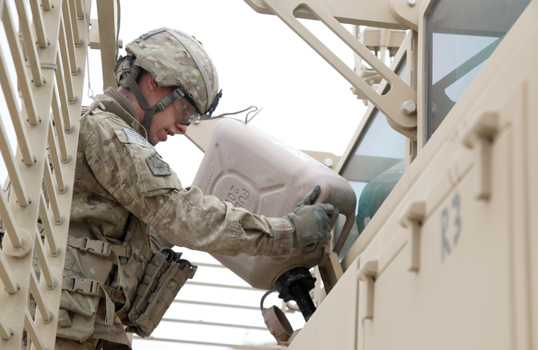
A soldier refuels his gas-guzzling MRAP armored truck in Afghanistan.
In Afghanistan today, however, the challenge is getting everything back out — or destroying it, selling it, or giving it away. Yes, it’s painful to put a half-million-dollar MRAP vehicle through a giant shredder, Harnitchek acknowledged, but you’re never going to recoup that $500,000: “look at this as a sunk cost, much like a business would do,” he said — and it’ll cost even more money to ship it home and store it, unused, for years. (Harnitcheck emphasized it’s not DLA that decides whether to keep a given vehicle, destroy it, or give it to the Afghans — he just does what the armed services ask him).
Equipment not meant for combat, by contrast, is generally safe to sell on the open market. There are still complications. Notably, the Afghan government demands Afghan companies pay import duties on what they buy from the US military, because the US didn’t pay them during the war. Nevertheless, DLA has rounded up millions of dollars worth of surplus material, from cutlery to bulldozers, and will start selling it off to local Afghans, Harnitchek said.
This is all-important but unglamorous work. DLA only makes headlines when something goes wrong, like last year, when the Pentagon’s Inspector General found DoD had overpaid Boeing $13 million for spare parts, including $2,286 for a part that normally cost $10. Harnitchek said today that’s all been settled. What the media missed, he said, was that DLA also shortchanged Boeing almost $10 million. “We overpaid for some, we underpaid for some,” he said. “The net was… $3.36 million,” which Boeing will pay in free parts rather than in cash.
Both the Boeing “scandal” and the Afghan sales, however, are basically rounding errors in a $40 billion annual enterprise. That’s down from $46 billion at its wartime peak, Harnitchek said, and headed down to $37 or even $35 billion this fiscal year. The $2 billion uncertainty reflects the unpredictabilities of operational demand, especially as the US figures out its post-2014 commitment in Afghanistan. Over the Future Years Defense Plan period from 2014 to 2019, he said, the DLA expects to save the Defense Department $13 billion.
That brings us back to the infrastructure and inventory cuts mentioned at the opening of this article. Over the last two years or so, “we’ve taken.. about five of our $15 billon dollars in inventory out of the system,” Harnitchek said. “If you don’t need the inventory, you certainly don’t need the World War II-vintage buildings that it goes in, so….we’ve taken the equivalent of about 45 football fields of covered storage out. That’s warehouses that are coming down.”
(If you wince at the image of the government tearing down taxpayer-funded buildings, remember the words “sunk cost” and that these aging warehouses can be expensive to keep up).
DLA is getting more efficient as well as smaller, Harnitchek said. Already the agency has cut average time to award a contract by about 35 percent, and the goal is to double that figure. That requires taking the risk of trusting government employees to do their jobs: “We have gotten a little overbearing in terms of contract review,” Harnitchek said. His personnel are trained professionals, he said, “[so] we’re taking out a lot of what we think is unnecessary review time.”
Unlike other defense agencies, though, DLA doesn’t need Congress to change the law to reduce the layers of review, Harnitchek said. “I don’t really need anything in terms of legislative relief that will make me any more effective or any more efficient,” he said. “It’s really all up to us now.”
No service can fight on its own: JADC2 demands move from self-sufficiency to interdependency
Making all-domain operations a warfighting capability means integrating, fusing, and disseminating a sensor picture appropriate for a particular theater segment, not all of them, says the Mitchell Institute’s David Deptula.



